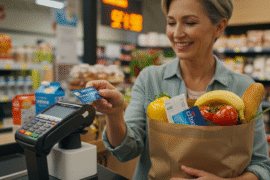This article may contain references to products or services from one or more of our advertisers or partners. We may receive compensation when you click on links to those products or services. Nonetheless, our opinions are our own.
The information presented in this article is accurate to the best of our knowledge at the time of publication. However, information is subject to change, and no guarantees are made about the continued accuracy or completeness of this content after its publication date.
In recent months, you may have heard about a popular supermarket chain making headlines for a more sobering reason: the closure of hundreds of its stores nationwide. While many have relied on these familiar aisles for weekly groceries and everyday essentials, the reality of these closures raises critical questions about the future of retail and what it means for communities like yours. As we examine the factors behind this decision, consider the impact it may have on your shopping habits, local economies, and the broader grocery landscape. Here’s a closer look at the circumstances leading to this shift—and what it could mean for customers navigating these uncertain changes.
- Understanding the Reasons Behind Store Closures and What It Means for You
- How to Adapt Your Shopping Habits in Response to Store Closures
- The Financial Impact of Losing a Local Supermarket and Your Budget
- Exploring Alternative Shopping Options for Cost-Effective Grocery Solutions
- Tips for Maximizing Savings During This Transition Period
- Planning for Future Grocery Needs Amidst a Changing Retail Landscape
- Frequently Asked Questions
- Recommended Reads
Understanding the Reasons Behind Store Closures and What It Means for You
When you hear about a major supermarket chain closing hundreds of stores, it can trigger concern, from job losses to uncertainty about where to shop. Understanding the reasons for these closures can help you better navigate the evolving retail environment. Several contributing factors include:
Shifting consumer preferences: More shoppers opt for online grocery shopping and delivery, leaving traditional stores struggling.
Rising operational costs: Expenses like rent, utilities, and labor continue to strain profitability, especially in areas with declining foot traffic.
Market competition: Increased pressure from discount retailers and local markets is prompting larger chains to reassess their presence in certain regions.
So what does this mean for you? As stores close, adapting your shopping habits becomes more critical. Consider exploring local markets or other grocery chains that may offer competitive prices. Monitor sales and utilize store loyalty programs to optimize your savings. Here’s a quick comparison of shopping options:
| Shopping Option | Pros | Cons |
|---|---|---|
| Local Markets | Fresh produce supports local farmers | It can be more expensive than larger chains |
| Online Grocery Delivery | Convenient, saves time | Delivery fees may lack local produce |
| Discount Chains | Lower prices are reasonable for budget shopping | Limited selection of premium products |
By understanding these shifts, you can make smarter choices that help you save while staying aware of changes in your community.
How to Adapt Your Shopping Habits in Response to Store Closures
As store closures become more common, you must rethink your shopping approach. Exploring local markets or smaller grocery stores may provide fresh produce and unique items often overlooked by larger chains. Consider these strategies when planning your next trip:
Plan: Create a shopping list based on essentials to avoid impulse buys and focus your spending.
Embrace discounts: Look for loyalty programs and digital coupons. Many smaller stores offer deals that can help stretch your budget.
Utilize delivery services: If traveling farther is challenging, consider grocery delivery options. Many offer competitive pricing and flexible delivery schedules.
You may also want to reevaluate bulk-buying habits. Limited availability could lead to higher prices in some stores, so weigh the cost-effectiveness of large quantities against fresher, smaller purchases. Here’s a quick comparison:
| Aspect | Bulk Buying | Fresh Products |
|---|---|---|
| Cost | Often cheaper per unit | Varies, but fresher options |
| Storage | Requires storage space | Needs to be used quickly |
| Quality | Depends on the product | Generally higher quality |
Adjusting your approach now allows you to shop more confidently and with less stress despite changing store availability.
The Financial Impact of Losing a Local Supermarket and Your Budget
Closing a local supermarket can significantly affect your routine and budget. Losing access to a trusted grocery store often means reassessing where you shop, leading to higher costs. You might need to travel farther, increasing gas expenses and taking up more time. Additionally, reduced competition can result in higher prices at remaining stores.
To manage the financial impact, consider the following strategies:
Reevaluate your shopping habits: Explore nearby stores, farmers’ markets, or co-ops that may offer competitive pricing.
Plan your meals: Meal planning can help minimize impulse purchases and keep grocery spending under control.
Use apps and coupons: Leverage technology to find sales or access digital coupons.
Here’s a sample comparison to show how prices can change between your old and new shopping locations:
| Item | Old Supermarket Price | New Supermarket Price |
|---|---|---|
| Milk (1 gallon) | $3.29 | $4.00 |
| Bread (loaf) | $2.50 | $3.00 |
| Eggs (dozen) | $2.00 | $2.50 |
By recognizing these shifts and adjusting your budget, you can reduce the strain on your finances while controlling your grocery needs.
Voted "Best Overall Budgeting App" by Forbes and WSJ
Monarch Money helps you budget, track spending, set goals, and plan your financial future—all in one app.
Get 50% OFF your first year with code MONARCHVIP
Exploring Alternative Shopping Options for Cost-Effective Grocery Solutions
With hundreds of stores closing, now is a good time to explore cost-effective alternatives to traditional supermarkets. These options can help you maintain your budget while accessing essential food items.
Consider the following:
Local farmers’ markets often offer fresh, affordable produce and support local agriculture by eliminating the middleman.
Discount grocery stores: These chains usually carry a wide range of staples at lower prices, making them ideal for budget-conscious shoppers.
Co-ops: Cooperative stores allow members to buy in bulk and share savings. They also provide a sense of community.
Online grocery delivery: Compare multiple services to find the best deals, and look for subscription discounts or free delivery options.
Tracking your expenses can help you identify patterns and stay within budget. Here’s a simple example:
| Week | Store | Amount Spent ($) |
|---|---|---|
| 1 | Farmers’ Market | 25 |
| 2 | Discount Store | 40 |
| 3 | Co-op | 30 |
| 4 | Online Delivery | 35 |
You can save money by staying proactive and open to alternatives while keeping your kitchen stocked with the essentials.
Tips for Maximizing Savings During This Transition Period
As you adjust to these changes, staying proactive with your finances is key. Here are several practical strategies to boost your savings:
Reassess your budget: Review your current spending and reduce non-essentials where possible.
Take advantage of store closures: Visit closing locations for potential clearance deals.
Stay updated on promotions: Sign up for emails or download the app of nearby supermarkets to access exclusive discounts.
Plan meals around sales: Check flyers or websites before shopping and build your meals around discounted items.
You can also challenge yourself to reduce spending with a simple savings plan:
| Week | Goal | Suggested Savings |
|---|---|---|
| Week 1 | Pack lunches instead of buying | $20 |
| Week 2 | No takeout meals | $30 |
| Week 3 | Family game night instead of dining out | $50 |
By committing to small changes and monitoring your habits, you’ll be better equipped to manage your finances through this transition.
Planning for Future Grocery Needs Amidst a Changing Retail Landscape
As the retail grocery landscape evolves, it’s important to plan. Store closures can disrupt your routine, but you can maintain control and flexibility with the right strategies.
Research alternative stores: Explore regional chains and local markets for better pricing and selection.
Use online shopping tools. Many retailers now offer delivery or curbside pickup, so use them to save time and avoid stock issues.
Join local initiatives: Community co-ops and farmers’ markets provide access to fresh food while supporting local businesses.
To help compare costs, here’s a simple breakdown:
| Item | Traditional Store Cost | Alternative Options Cost |
|---|---|---|
| Organic Vegetables | $3.00 per lb | $2.50 per lb (Farmers’ Market) |
| Packaged Snacks | $2.50 | $2.00 (Local Store) |
| Dairy Products | $4.00 | $3.50 (Co-op) |
Adapting your strategy saves money and helps you align your shopping with your values and long-term financial goals.
Frequently Asked Questions
Why is the supermarket chain closing hundreds of stores?
The company cited multiple reasons, including changing shopping habits, increased competition from online retailers, and financial difficulties exacerbated by the pandemic. As a result, they are restructuring and closing underperforming locations.
Which stores are closing?
Closures occur in urban and suburban areas where sales did not meet expectations. The company is focusing on strong-performing regions and cutting overhead where profits are low.
How will this impact employees?
The company has stated it will support affected employees, such as reassignment opportunities and severance packages. However, some employees may face job loss due to the large number of closures.
What should customers know about the store closures?
Customers may find that their usual shopping locations are no longer open. The chain is directing shoppers to nearby stores and plans to hold clearance sales as affected locations close.
Are there plans for the future of the supermarket chain?
Yes. The company is restructuring to focus on profitability and efficiency. Investments in technology and e-commerce are planned to enhance customer experience and explore new market opportunities.

Reviewed and edited by Albert Fang.
See a typo or want to suggest an edit/revision to the content? Use the contact us form to provide feedback.
At FangWallet, we value editorial integrity and open collaboration in curating quality content for readers to enjoy. Much appreciated for the assist.
Did you like our article and find it insightful? We encourage sharing the article link with family and friends to benefit as well - better yet, sharing on social media. Thank you for the support! 🍉
Article Title: Popular Supermarket Chain Closing Hundreds of Stores
https://fangwallet.com/2025/03/29/popular-supermarket-chain-closing-hundreds-of-stores/The FangWallet Promise
FangWallet is an editorially independent resource - founded on breaking down challenging financial concepts for anyone to understand since 2014. While we adhere to editorial integrity, note that this post may contain references to products from our partners.
The FangWallet promise is always to have your best interest in mind and be transparent and honest about the financial picture.
Become an Insider

Subscribe to get a free daily budget planner printable to help get your money on track!
Make passive money the right way. No spam.
Editorial Disclaimer: The editorial content on this page is not provided by any of the companies mentioned. The opinions expressed here are the author's alone.
The content of this website is for informational purposes only and does not represent investment advice, or an offer or solicitation to buy or sell any security, investment, or product. Investors are encouraged to do their own due diligence, and, if necessary, consult professional advising before making any investment decisions. Investing involves a high degree of risk, and financial losses may occur including the potential loss of principal.
Source Citation References:
+ Inspo
There are no additional citations or references to note for this article at this time.












































